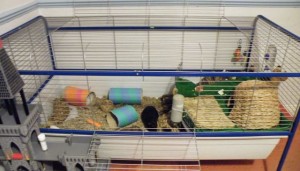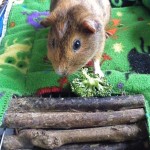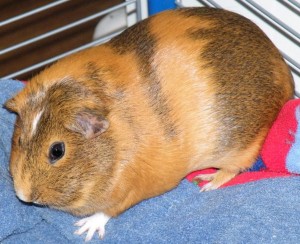
Guinea pigs don’t like open space so this indoor cage has clutter. c. Carrie and Simon Evans. www.petbehave.co.uk
Buy as large an indoor cage as you can afford. Tiny cages make guinea pigs stressed (Normando & Gelli 2011). Think carefully before you buy. Larger cages are often designed for rabbits and may not be suitable. Be careful about double storey cages, as frightened or elderly guinea pigs can injure themselves by falling off the ramp. Covered ramps or ramps with side walls are safer.

Safer ramp using lounge logs. c. Carrie and Simon Evans. www.petbehave.co.ukAnd here.
If you get a large cage with a simple floor you can add what you want in it. There always should be a guinea pig house for your guinea pigs to retreat into, a litter tray, very deep litter of hay or straw to burrow in, a hay rack placed at a suitable height. If you are going to let your guinea pigs out into the room, make sure you guinea proof it first so that they don’t disappear into nooks and crannies or under furniture from where you cannot retrieve them. cover or remove electrical wires from their reach.
Best practice for laboratories is 2,500 square centimeters per animal, ie. 5000 square centimeters for a pair of adults (Kaiser et al., 2010). Height should be a minimum of 30 cms. I would hope that pet owners would be as or more generous than animal labs. Guinea pigs don’t like wide open spaces so put stuff like hay to tunnel through and pipes/boxes to crawl through in the middle of the space.
The cage should be placed away from radiators, windows, or hot areas. Guinea pigs suffer from heat more than cold (Kaiser et al., 2010). The ideal indoor temperature should be about 18-22 degrees Centigrade. Keep the cage in a quiet room as guinea pigs suffer from loud noises (McBride 2011). Keep it away from draughts. Keep guinea pigs away from cats or dogs.
LITTER
Wood shavings or sawdust should never be used as litter or bedding even if they were traditional in the past. They are dusty and leave the animal prone to health problems. Put a layer of newspaper at the bottom of the cage. Litter on top of the newspaper should be very deep paper bedding or very deep hay (McBride 2011) or Megazorb (used by Wheek and Squeak rescue), or Carefresh or Aubiose litter with some hay to tunnel in. Having litter to tunnel in reduces their stress.

c. Carrie and Simon Evans. www.petbehave.co.uk
BEDDING
Many people use fleece for indoor guinea pigs. Obviously in a warm house, it is less important to have a lot of bedding. But if the guinea pigs are in an outhouse or a coldish room, make sure they have warm bedding for the colder months. Never buy small pet fluffy bedding, even if it is sold in pet shops, in case they eat it, and it blocks their gut. Lots of dry good hay is best.
CLEANING REGIME.
This can be found on How should I house my outdoor guinea pig.
REFERENCES.
Kaiser, S., Kruger, C. & Sachser, N, (2010), ‘The Guinea Pig,’ in eds Hubrecht & Kirkwood, J., The UFAW Handbook on Care and Management of Laboratory and other Research Animals, Eight Edition, Wiley-Blackwell, Chichester, UK, 381-398
McBride, A., (2011), Guinea Pigs. Understanding and caring for your pet, Magnet & Steel.
Normando, S. & Gelli, G., ‘Behavioral complaints and owners’ satisfaction in rabbits, mustelids, and rodents kept as pets,’ Journal of Veterinary Behavior, 6, 337-342.
Reinhard, V., ‘Comfortable Quarters for Guinea-pigs in Research Institutions,’ in eds Reinhardt, V., & Reinhardt, A., Comfortable Quarters for Laboratory Animals, Ninth Edition, Washington DC, USA, Animal Welfare Institute,38-42.